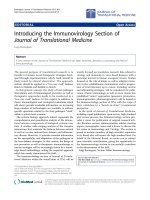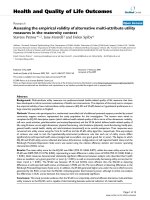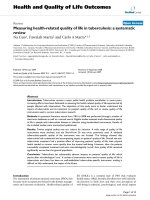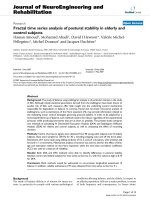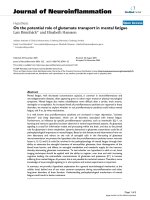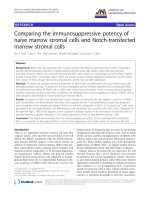Báo cáo hóa học: " Improving the emission efficiency of MBE-grown GaN/AlN QDs by strain control" doc
Bạn đang xem bản rút gọn của tài liệu. Xem và tải ngay bản đầy đủ của tài liệu tại đây (1.28 MB, 6 trang )
NANO EXPRESS Open Access
Improving the emission efficiency of MBE-grown
GaN/AlN QDs by strain control
Lang Niu, Zhibiao Hao
*
, Jiannan Hu, Yibin Hu, Lai Wang and Yi Luo
Abstract
The quantum-confined stark effect induced by polarizati on has significant effects on the optical properties of
nitride heterostructures. In order to improve the emission efficiency of GaN/AlN quantum dots [QDs], a novel
epitaxial structure is proposed: a partially relaxed GaN layer followed by an AlN spacer layer is inserted before the
growth of GaN QDs. GaN/AlN QD samples with the proposed structure are grown by molecular beam epitaxy. The
results show that by choosing a proper AlN spacer thickness to control the strain in GaN QDs, the internal
quantum efficiencies have been improved from 30.7% to 66.5% and from 5.8% to 13.5% for QDs emitting violet
and green lights, respectively.
Keywords: GaN QDs, quantum-confined stark effect, internal quantum efficiency
Introduction
Recently, with progress in the growth of high-quality
bulk AlN [1,2], a lot of efforts have been devoted to
GaN/AlN quan tum dots [QDs] because of their unique
properties such as broad emission wavelength range
covering the whole visible light, which provides a pro-
mising way to achieve white light-emitting diodes
[LEDs] [3]. Besides, the large cond uction band offset
(approximately 2 eV for GaN/AlN) offers a prospect to
cover the fiber o ptical telecommunication wavelength
range (1.3 to 1.55 μm) by intersubband transition [4,5].
By controlling the growth conditions, the sizes and
densities of the GaN/AlN QDs can be varied, and the
photoluminescence [PL] wavelength can also b e tuned.
However, the large lattice mismatch between GaN and
AlN and their polarization properties induce a strong
built-in electric field, cau sing a remarkable quantum-
confined stark effect [QCSE] which reduces the interna l
quantum efficiency [IQE] of the QDs. The reason is that
the built-in electric field leads to energy ban d decline
and separation of electron and hole wave functions,
resulting in the decrease of recombination efficiency as
well as the red shift of emission wavelength. Further-
more, the emission peak shifts to a shorter wavelength
with increasing injection current, w hich is caused b y
Coulomb screening of the internal electric field [6]. Thi s
phenomenon also exists in InGaN/GaN materials. In
order to suppress the influence of QCSE, the compres-
sive strain in the QD structures should be decreased,
whereas, on the other hand, a certain degree of strain is
required to perform the Stranski-Krastanov [S-K] mode
growth of QDs. Therefore, it is a crucial issue to control
the strain distribution in order to improve the IQE of
GaN/AlN QD emission.
Nowadays, some work has been done to avoid the
QCSE. Adelmann et al. grew self- assembled cubi c GaN
QDs by using plasma-assisted molecular-beam epitaxy
[PA-MBE] on cubic AlN [7]. However, due to the very
narrow growth window, it was difficult to grow high-
quality GaN bulk and QDs. Cros et al. reported GaN/
AlN QD growth on a-plane 6H-SiC [8,9]. This method
suffered from an extremely expensive substrate, and
compared with the GaN and AlN bulks grown on c-
plane, the crystal quality still needed to be improved.
Furthermore, an AlGaN buffer layer has been used
instead of AlN to reduce the polarization effect [10].
However, a certain surfactant was required in order to
achieve the two-dimensional to three-dimensional [2D-
to-3D] growth transition [11]. Also, the bandgap of
AlGaN is smaller than that of AlN; thus, the strong con-
finement in GaN QDs is weakened.
* Correspondence:
Department of Electronic Engineering, Tsinghua National Laboratory for
Information Science and Technology, Tsinghua University, Beijing 100084,
People’s Republic of China
Niu et al. Nanoscale Research Letters 2011, 6:611
/>© 2011 Niu et al; licensee Springer. This is an Open Access article distributed under the terms of the Creative Commons Attribution
License ( which permits unrestricted use, distribution, and repr oduction in any medium,
provided the original work is properly cited.
In our previous experiments, GaN/AlN QDs with var-
ied morphologies have been obtained by properly choos-
ing the growth parameters. The emission peaks of the
QDs vary from 400 to 670 nm, and the QDs with a lar-
ger avera ge height exhibit a longer emission wavelength
but with a lower efficiency, due to the influence of
QCSE. In this work, the morphologies and emission
properties of GaN QDs grown on a partially relaxed
AlN layer are investigated. The emission efficiencies of
GaN QDs have been obviously improved by controlling
the strain status of the underneath AlN layer.
Experiments
In order to improve the emission efficiency of GaN/AlN
QDs, we propose a novel epitaxial structure to control
the s train in GaN QDs by inserting a GaN layer under
the AlN barrier layer. The epitaxial structures of GaN/
AlN QDs are illustrated in Figure 1. For the proposed
QD structure, as shown in Figure 1b, a 100-nm-thick
GaN insertion layer is grown above the AlN buffer, fol-
lowed by an AlN spacer with varied thickness, then
GaN QDs, and an AlN cap layer. The GaN insertion
layer is designed to be partially relaxed; hence, the strain
status of the following AlN spacer and GaN QDs can be
controlled by varying the thickness of the AlN spacer.
The samples were grown on c-plane sapphire sub-
strates by PA-MBE. Reflection high-energy electron dif-
fraction [RHEED] a nd optical reflection spectrum were
used to monitor the growth in si tu.TheAlandGa
sources were supplied by conventional Knudsen effusion
cells. Two sets of samples were prepared with different
AlN spacer thicknesses. Control samples, with a conven-
tional structure as shown in Figure 1a, were grown with-
out the GaN insertion layer. Table 1 summarizes the
structural parameters of the samples. One set of samples
emits violet light (around 400 nm), while the other set
of samples grown under higher substrate temperature
emits green light (around 520 nm). Samples without the
AlN cap layer were also prepared for morphology
measurement.
The samples’ surface morphologies were meas ured by
scanning electron microscopy [SEM] and atomic force
microscopy [AFM]. The crystalline propert ies were
examined by transmission electron microscopy [TEM]
and X-ray diffraction [XRD]. To evaluate the samples’
optical properties, temperature-dependent PL measure-
ments were carried out using a 325-nm laser as
excitation.
Results and discussion
As mentioned above, a partially relaxed GaN insertion
layer is introduced in order to control the strain status
of the GaN QDs. Figure 2 shows the typical XRD reci-
procal space mapping measurement result of the sam-
ples. The relaxation factor c an be defined as (a
GaN-epi
-
a
AlN-bulk
)/(a
GaN-bulk
-a
AlN-bulk
), where a
GaN-epi
is the in-
plain lattice constant of the GaN insertion layer, and
a
GaN-bulk
and a
AlN-bulk
are the standard in-plain lattice
constants of GaN and AlN bulks [12]. Acco rding to the
XRD reciprocal mapping data, the relaxation factor of
the GaN insertion layer is calculated to be 63.3% , which
manifests that the insertion layer is partially relaxed, and
the in-plain lattice constant of the top GaN is larger
than that of the AlN bulk. Then, the subsequently
grown AlN spacer is under tensive strain, and the strain
status varies according to its thickness, i.e., the thicker
AlN spacer is with a smaller in-plain lattice due to
relaxation. The high resolution cross-sectional TEM
image of the GaN/AlN QDs is shown in Figure 3, which
reveals that the GaN QDs are grown coherently with
Figure 1 Schematics of the (a) conventional and (b) proposed epitaxial structures of GaN/AlN QDs.
Niu et al. Nanoscale Research Letters 2011, 6:611
/>Page 2 of 6
the lattice of the AlN layer and have the same in-plain
lattice constant with the AlN spacer. Therefore, by vary-
ing the thickness of the AlN spacer, the strain of GaN
QDs can be controlled; thicker AlN spacer results in a
larger strain in GaN QDs.
Initially, the samples emitting violet ligh t are analy zed.
Among the four samples described in Table 1, according
to the aforementioned structural properties, the GaN
QDs in s ample A have the largest strain, while the QDs
in sample D have the smallest strain. As observed from
the RHEED patterns for S-K growth of GaN QDs, it
takes 18, 25, 30, and 35 s for samples A, B, C, and D,
respectively, to complete the 2D-to-3D transition. This
indicates that from samples A through D, the critical
thickn ess for QD formation increases orderly due to the
reduction in strain, and as a result, larger and higher
dots will be formed because of more GaN accumulated
during the process. As shown in Figure 4, the SEM mea-
surement reveals that the average QD diameter
increases o bviously from samples A through D, along
with the decreased QD density. According to the AFM
measurements, the mean QD heights of samples A, B,
C, and D are 1.1, 1.5, 1.9, and 2.9 nm, respectively.
These morphology characteristics are summarized in
Table 1.
Figure 5 shows the room-temperature PL spectra of
the four samples. The emission peaks of samples A, B,
and C are all approximately 400 nm, while the PL peak
of sample D exhibits a small red shift. By performing
the temperature-dependent PL measurement from 4 K
to 300 K, the IQE of the QDs can be calculated by the
ratio of the integral PL intensity at 300 K to that at 4 K,
and the results are shown in Figure 6. It can be seen
that the IQE of sample A with conventional structure is
30.7%, and the IQE increases to 66.5% for sample C
with a 40-nm thickness of AlN spacer. As for sample D
which has the thinnest AlN spacer of 20 nm, the IQE
drops a little to 58.7%.
There are two factors when considering the influence
of QCSE on the IQE of the QDs: one is the strain-
induced internal electric field, and the other is the QD
morphology. A careful simulation is required to fully
understand the influ ence of QD morphology. Ngo et al.
reported that the emission wavelength of QDs exhibits a
red shift with the increasing QD height, base, volume,
oraspectratio[AR]atafixedvolume[13].Forour
samples, as seen in Table 1, the QD diameter, aspect
ratio, and volume increase with the QD height. There-
fore,inordertosimplifythediscussion,weonlycon-
sider the QD height in the following part.
For GaN/AlN QDs, when either the internal electric
field or the QD height increases, the IQE will decrease
due to the reduction of the electron-hole overlap [14];
at the same time, a red shift of the emission pe ak can
Table 1 Structural parameters of the GaN/AlN QD samples and the measured morphology characteristics
Sample AlN spacer thickness
(nm)
GaN insertion layer thickness
(nm)
QD density (cm
-
2
)
Mean QD height
(nm)
Mean QD diameter
(nm)
QD
AR
A N/A None 4.4 × 10
11
1.1 10.2 0.11
B 60 100 4.0 × 10
11
1.5 10.5 0.14
C 40 100 2.2 × 10
11
1.9 11.8 0.16
D 20 100 9.6 × 10
10
2.9 17.2 0.17
Figure 2 XRD reciprocal space mapping measurement result of a typical sample.
Niu et al. Nanoscale Research Letters 2011, 6:611
/>Page 3 of 6
Figure 3 High-resolution cross-sectional TEM image of the
GaN/AlN QDs.
Figure 4 SEM images of the GaN QD samples.
Figure 5 Room-temperature PL spectra of the GaN QD
samples.
Niu et al. Nanoscale Research Letters 2011, 6:611
/>Page 4 of 6
be observed. On the contrary, reduction in either of
these two factors will lead to impr ovement of the emis-
sion efficiency and blueshift of the emission peak. For
samples from A through D, the internal electric field
decreases, while the QD height increases; the ultimate
effects depend on which factor is dominant. The fact
that the emission efficiency increases from samples A
through C means that for these samples, t he effect on
emission efficie ncy from the reduction in internal elec-
tric field overcomes that from the QD height. On the
other hand, samples A, B, and C exhibit almost the
same emission peak wavelength. This is because the
incre ase of QD height and the decrease of internal elec-
tric field balance out the influence on the emission
wavelength. As for sample D, the emission efficiency
drops and the emission peak red shifts about 10 nm,
due to the large QD height playing a dominant role.
How these two factors affect the IQE is illustrated in
Figure 7.
This mechanism also accounts for the improvement of
the samples emitting green ligh t. The IQE of the sample
without the GaN insertion layer is only 5.8%, while for
the sample with the proposed epitaxial structure, the
IQE has been improved to 13.5%. These results imply a
promising way to optimize the performance of QD
LEDs.
Conclusions
GaN/AlN QD samples with a partially relaxed GaN
insertion layer followed by an AlN spa cer layer have
been grown b y PA-MBE. The proposed structure can
control the strain in GaN QDs and thus the QCSE
induced by polarization. As a result, the IQEs for GaN
QDs emitting violet and green lights have been
improved from 30.7% to 66.5% and from 5.8% to 13.5%,
respectively. And for the samples with the AlN spacer of
a certain range of thickness, the emission wavelength
keeps nearly unchanged when the IQE increases.
Acknowledgements
This work was supported by the National Basic Research Program of China
(grant nos. 2011CB301902 and 2011CB301903), the High Technology
Figure 6 The IQEs of the sa mples obtai ned by tempera ture-
dependent PL measurements.
Figure 7 Illustration of the effects of internal electric field and QD height on the GaN QDs.
Niu et al. Nanoscale Research Letters 2011, 6:611
/>Page 5 of 6
Research and Development Program of China (grant nos. 2011AA03A112,
2011AA03A106, and 2011AA03A105), the National Natural Science
Foundation of China (grant nos. 61176015, 60723002, 50706022, 60977022,
and 51002085), and the Beijing Natural Science Foundation (grant no.
4091001).
Authors’ contributions
LN wrote, conceived, and designed the experiments. LN, ZBH, JNH, and YBH
grew the samples and analyzed the data. LN, LW, and YL did all the
measurements. All authors discussed the results, contributed to the
manuscript text, commented on the manuscript, and approved its final
version.
Competing interests
The authors declare that they have no competing interests.
Received: 6 September 2011 Accepted: 2 December 2011
Published: 2 December 2011
References
1. Ren F, Hao ZB, Hu JN, Zhang C, Luo Y: Effects of AlN nucleation layer
thickness on crystal quality of AlN grown by plasma-assisted molecular
beam epitaxy. Chin Phys B 2010, 19:116801.
2. Ren F, Hao ZB, Zhang C, Hu JN, Luo Y: High quality A1N with a thin
interlayer grown on a sapphire substrate by plasma-assisted molecular
beam epitaxy. Chin Phys Lett 2010, 27:068101.
3. Damilano B, Grandjean N, Semond F, Massies J, Leroux M: From visible to
white light emission by GaN quantum dots on Si(111) substrate. Appl
Phys Lett 1999, 75:962.
4. Gmachl C, Ng HM, Chu S-NG, Cho AY: Intersubband absorption at λ ~1.55
μm in well- and modulation-doped GaN/AlGaN multiple quantum wells
with superlattice barriers. Appl Phys Lett 2000, 77:3722-3724.
5. Kishino K, Kikuchi A, Kanazawa H, Tachibana T: Ultrafast intersubband
relaxation and nonlinear susceptibility at 1.55 μm in GaN/AlN multiple-
quantum wells. Appl Phys Lett 2002, 81:1234.
6. Kuokstis E, Yang JW, Simin G, Khan MA, Gaska R, Shur MS: Two
mechanisms of blue-shift of edge emission in InGaN-based epilayers
and multiple quantum wells. Appl Phys Lett 2002, 80:977.
7. Adelmann C, Martinez-Guerrero E, Chabuel F, Simon J, Bataillou B, Mula G,
Dang LS, Pelekanos NT, Daudin B, Feuillet G, Mariette H: Growth and
characterisation of self-assembled cubic GaN quantum dots. Mater Sci
Eng B 2001, 82:212-214.
8. Cros A, Budagosky JA, Garca-Cristbal A, Garro N, Cantarero A, Founta S,
Mariette H, Daudin B: Influence of strain in the reduction of the internal
electric field in GaN/AlN quantum dots grown on a-plane 6H-SiC. Phys
Status Solidi B 2006, 243:1499-1507.
9. Garro N, Cros A, Budagosky JA, Cantarero A, Vinattieri A, Gurioli M,
Founta S, Mariette H, Daudin B: Reduction of the internal electric field in
wurtzite a-plane GaN self-assembled quantum dots. Appl Phys Lett 2005,
87:011101.
10. Fonoberov VA, Balandin AA: Excitonic properties of strained wurtzite and
zinc-blende GaN/AlxGa1-xN quantum dots. J Appl Phys 2003,
94:7178-7186.
11. Tanaka S, Iwai S, Aoyagi Y: Self-assembling GaN quantum dots on AlGaN
surfaces using a surfactant. Appl Phys Lett 1996, 69:4096.
12. Schuster M, Gervais PO, Jobst B, Hosler W, Averbeck R, Riechert H, Iberl A,
Stommer R: Determination of the chemical composition of distorted
InGaN/GaN heterostructures from x-ray diffraction data. J Phys D: Appl
Phys 1999, 32:56.
13. Ngo CY, Yoon SF, Fan WJ, Chua SJ:
Effects of size and shape on electronic
states of quantum dots. Phys Rev B 2006, 74:245331-245340.
14. Kubota M, Okamoto K, Tanaka T, Ohta H: Continuous-wave operation of
blue laser diodes based on nonpolar m-plane gallium nitride. APEX 2008,
1:011102.
doi:10.1186/1556-276X-6-611
Cite this article as: Niu et al.: Improving the emission efficiency of MBE-
grown GaN/AlN QDs by strain control. Nanoscale Research Letters 2011
6:611.
Submit your manuscript to a
journal and benefi t from:
7 Convenient online submission
7 Rigorous peer review
7 Immediate publication on acceptance
7 Open access: articles freely available online
7 High visibility within the fi eld
7 Retaining the copyright to your article
Submit your next manuscript at 7 springeropen.com
Niu et al. Nanoscale Research Letters 2011, 6:611
/>Page 6 of 6

